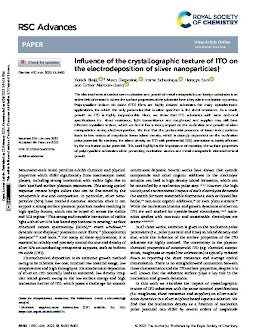2023-02-23
Influence of the crystallographic texture of ITO on the electrodeposition of silver nanoparticles
Publication
Publication
RSC Adv. , Volume 13 - Issue 10 p. 6490- 6497
The electrochemical control over nucleation and growth of metal nanoparticles on foreign substrates is an active field of research, where the surface properties of the substrate have a key role in nucleation dynamics. Polycrystalline indium tin oxide (ITO) films are highly desired substrates for many optoelectronic applications, for which the only parameter that is often specified is the sheet resistance. As a result, growth on ITO is highly irreproducible. Here, we show that ITO substrates with same technical specifications (i.e. sheet resistance, light transmittance and roughness) and supplier may still have different crystalline texture, which we find it has a strong impact on the nucleation and growth of silver nanoparticles during electrodeposition. We find that the preferential presence of lower index surfaces leads to few orders of magnitude lower island density, which is strongly dependent on the nucleation pulse potential. By contrast, the island density on ITO with preferential 〈111〉 orientation is barely affected by the nucleation pulse potential. This work highlights the importance of reporting the surface properties of polycrystalline substrates when presenting nucleation studies and metal nanoparticle electrochemical growth.
| Additional Metadata | |
|---|---|
| RSC | |
| The Netherlands Organisation for Scientific Research (NWO) | |
| doi.org/10.1039/d3ra00577a | |
| RSC Adv. | |
| Organisation | 3D Photovoltaics |
|
Bleiji, Y., Dieperink, M., Schuringa, I., Sun, H., & Alarcón-Lladó, E. (2023). Influence of the crystallographic texture of ITO on the electrodeposition of silver nanoparticles. RSC Adv., 13(10), 6490–6497. doi:10.1039/d3ra00577a |
|
